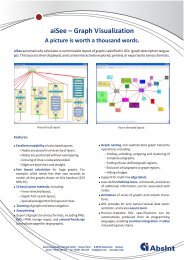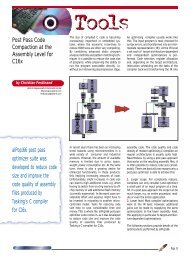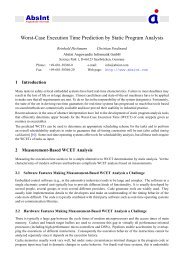5 Graph Description Language (GDL) - Absint
5 Graph Description Language (GDL) - Absint
5 Graph Description Language (GDL) - Absint
You also want an ePaper? Increase the reach of your titles
YUMPU automatically turns print PDFs into web optimized ePapers that Google loves.
}<br />
< list of node attributes ><br />
The title of a node is any valid C string. Strings have to be enclosed in quotes and may contain the<br />
normal C escapes (e. g. \", \n, \f, . . . ).<br />
5.3 Edge Format<br />
There are several different kinds of edges:<br />
• ordinary edges (see p. 43)<br />
• back edges (see p. 43)<br />
• near edges (see p. 44)<br />
• left near edges (see p. 44)<br />
• right near edges (see p. 44)<br />
• bent near edges (see p. 44)<br />
• left bent near edges (see p. 45)<br />
• right bent near edges (see p. 45)<br />
5.3.1 Ordinary Edge Format<br />
An ordinary edge is specified by<br />
edge: {<br />
source: < title of source node ><br />
target: < title of target node ><br />
< list of edge attributes ><br />
}<br />
5.3.2 Back Edge Format<br />
Back edges are drawn in the opposite direction as compared to ordinary edges. For instance, if the<br />
layout algorithm tries to give all ordinary edges a top-down orientation, it tries to give the back<br />
edges a bottom-up orientation.<br />
If a graph contains a cycle, not all edges can have the same orientation: Some edges have to be<br />
reversed. In this case, the layout algorithm prefers back edges before selecting any other edge to<br />
be reversed.<br />
A back edge is specified by<br />
backedge: {<br />
source: < title of source node ><br />
43





